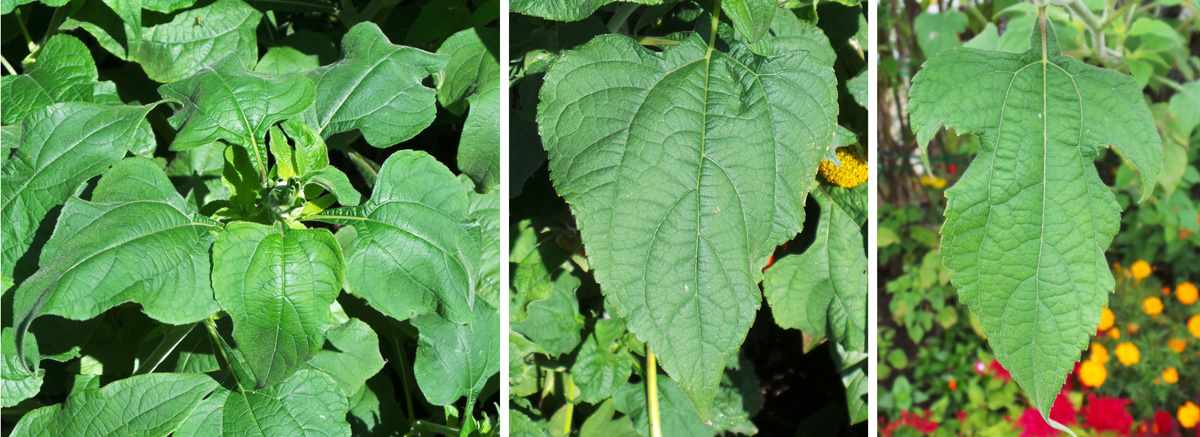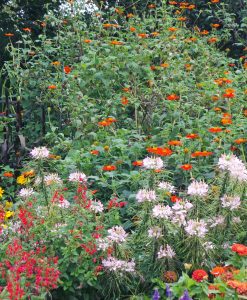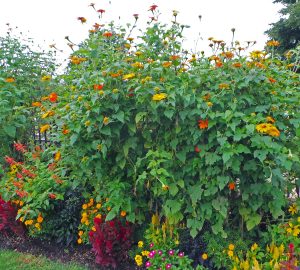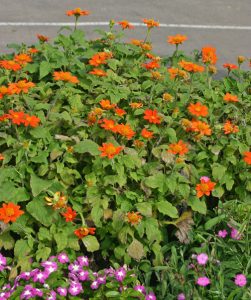
The genus Tithonia in the daisy family (Asteraceae) includes 10-15 species of bushy annuals, perennials and shrubs native to Mexico and Central America that have large, brightly colored daisy-like flowers on thick stems. Mexican sunflower, T. rotundifolia, is a vigorous, drought tolerant warm season annual that is easy to grow in the ornamental garden with other common names of red sunflower of just tithonia.
Tithonia plants grow 4-6+ feet tall with a large central stalk and a somewhat gangly branching habit. The stems can be brittle. The dark green leaves are ovate to deltoid (triangular) in shape with serrate to crenate margins. The coarse leaves are usually entire but occasionally will be three lobed. The foliage and stems are covered with a soft downy fuzz, and the underside of the leaves are hairy.

Flowers are produced from mid-summer until frost. The solitary flowers are borne on fragile hollow peduncles (flower stems) that are susceptible to being bent and are often broken by birds. Each 3-inch blossom has a number of bright red to orange ray flowers surrounding the central yellow disk flowers.


The flowers are attractive to a wide variety of bees, butterflies and hummingbirds, and can be used as cut flowers. Deadheading spent flowers will prolong blooming. The flowers are followed by grey to black flattened triangular seeds that are easy to collect to save to grow in subsequent years.


Because of its tall stature, rangy habit and coarse texture, this annual is best at the back of borders and beds to form a backdrop for shorter plants. It can be used as a seasonal screen (especially if grown from transplants started early in the season). Use in mixed or annual borders with tall zinnias, coreopsis, and other flowers in hot colors for a high-energy planting, or tone down the brilliant orange-red flowers by combining with purple flowers and larger plants with dark-colored foliage, such as annual ornamental millet or castor bean or in mixed beds with woody plants such as smokebush or ‘Diabolo’ eastern ninebark.

Tithonia grows best in full sun in poor to average, well-drained soil. Avoid planting in rich soil or heavy fertilization that with promote excess foliage and weak stems. Pinch back plants to encourage bushier growth. Sturdier plants are less likely to fall over but plants often need to be staked to remain upright. Shelter from strong winds if possible. It has few pest problems and is not favored by deer.
Grow tithonia from seed, either planted directly in the garden at the last frost date or started indoors 6-8 weeks before the average last date of frost for earlier blooms. Sow shallowly as as light is required for germination. Plant in the garden about two feet apart to provide support for adjacent plants, or place staked plants 3-4 feet apart. Since the plants tall with brittle stems, try to provide shelter from strong winds, but even in areas that are not windy these plants benefit from staking. It needs warm sunny weather to grow well so may not do much early in the season. In cool summers, late-planted direct-seeded plants may not bloom.

Only a few cultivars are generally available:
- ‘Fiesta del Sol’ – is a shorter cultivar that only grows about 3 feet tall. It was an AAS award winner in 2000.
- ‘Goldfinger’ – is a short variety (2-2.5 feet tall) better suited to small gardens with orange-gold flowers.
- ‘Torch’ – is the most commonly offered cultivar, winning an AAS award in 1951.
- ‘Yellow Torch’ – has apricot yellow-orange flowers.
– Susan Mahr, University of Wisconsin – Madison
newline]





 Marigolds
Marigolds Create a Butterfly Garden
Create a Butterfly Garden Plant Flowers to Encourage Beneficial Insects
Plant Flowers to Encourage Beneficial Insects Forcing Bulbs
Forcing Bulbs


